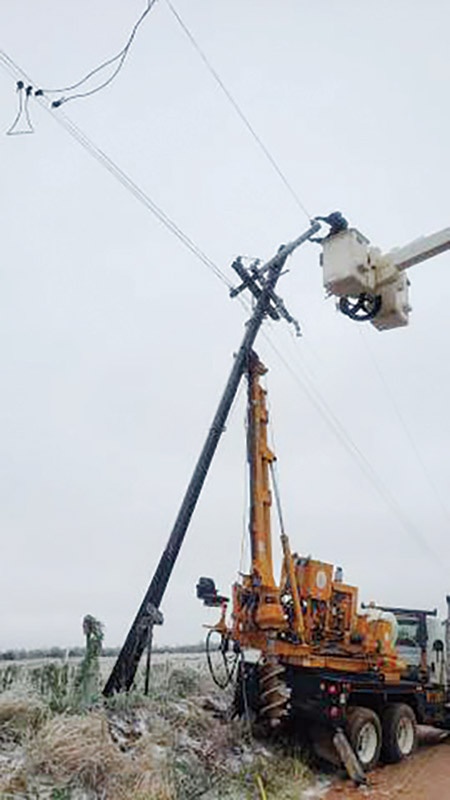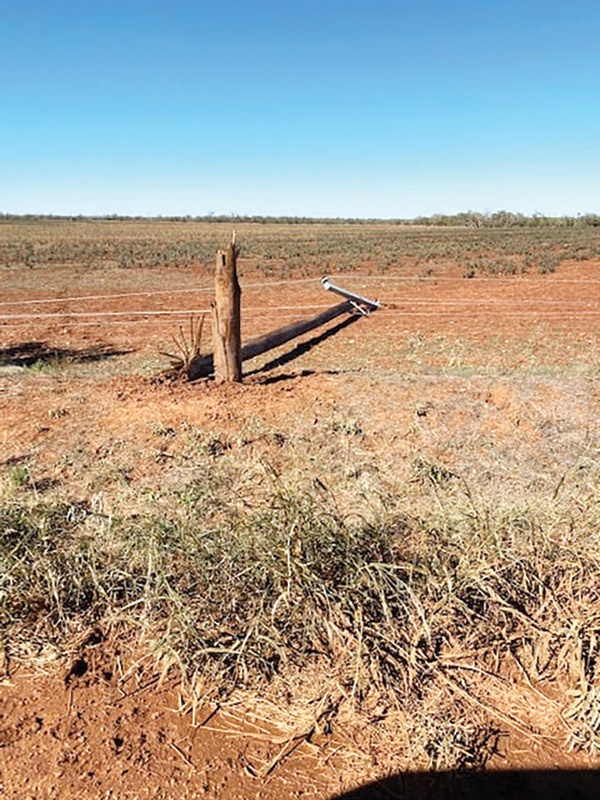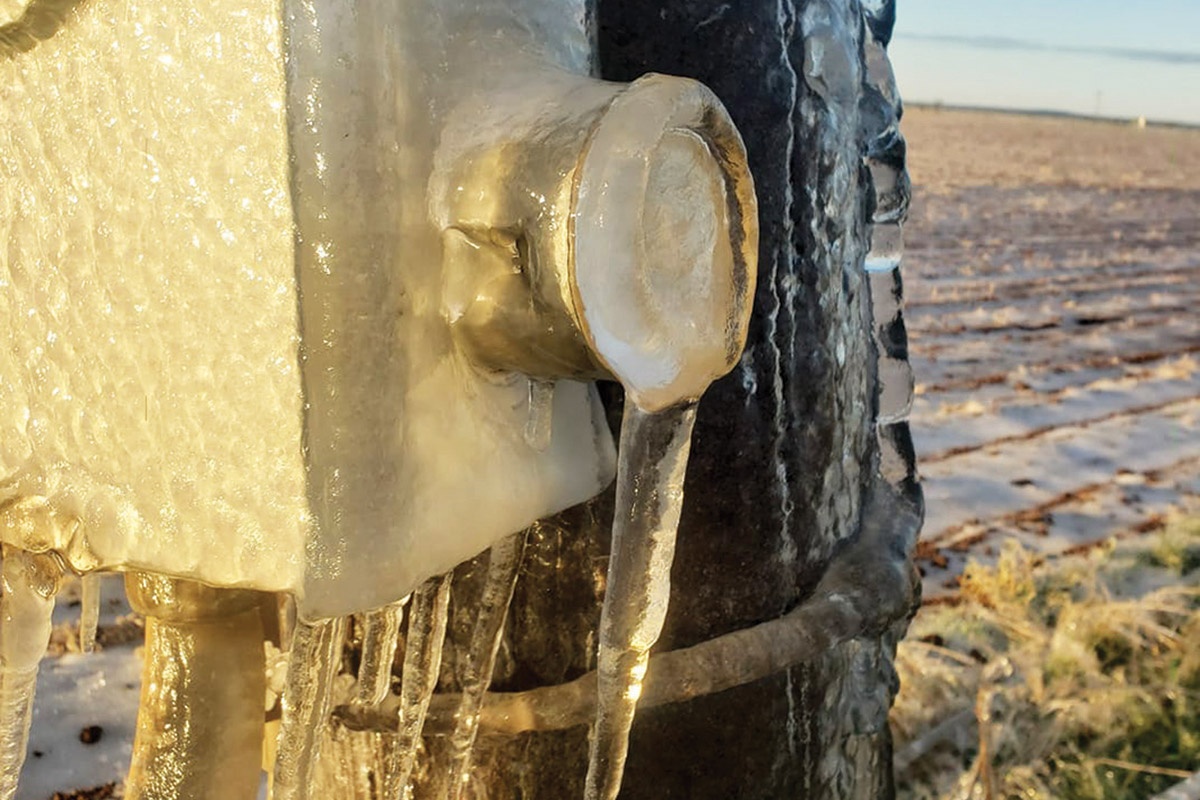October was a typical busy month for Big Country Electric Cooperative—until the last few days of the month, when the ice storm hit. Then it was busy around the clock through the first week of November.
Many Big Country EC members were without power for several hours October 28. For many of those members, that outage extended into the evening and, for some, even through the night. Some spent much of the next day without power and a few remained without power even into Friday. That may seem odd, since after it warmed up the very next day, the ice began to melt and the sky was bright and blue.
Electric cooperatives dread ice more than other forms of foul weather because ice packs a one-two punch. The jab is the weight of the ice, which snaps lines and can pull poles and crossarms down, along with trees, which can fall on lines, causing outages. Thawing is the right cross: The weight and movement of ice falling off lines makes them bounce and slap together, which causes more outages. In the aftermath of the October ice storm, the wind and falling tree branches tore some lines down as soon as we got them back up, making a challenging job that much harder.

Big Country Electric Cooperative
With ice, it’s almost always a no-win situation for a utility. Access into many areas was stymied by melting ice that turned into mud, which ensnared BCEC’s big, heavy trucks. Bulldozers must be brought in to free stuck trucks, but unloading that equipment, deploying it, and getting it reloaded and sent to another location to repeat the process is very slow work.
Think of Big Country EC’s electrical system like a spiderweb, extending out from substations to deliver power to different circuits. Those circuits feed power to main lines that are controlled by breakers, which deliver power to many smaller lines that branch off in different directions to serve homes, farms, oil wells and businesses. Just as a spider rebuilds its web from the middle and works out from there, we always start by locating the core of outages. This means repairing the locations that will restore power soonest for the greatest number of people and most critical services such as hospitals or medical priority members, then working our way out to more isolated instances.

Big Country Electric Cooperative
It’s impossible to start with individual, isolated outages because the problem may be coming from where electricity is fed, which may be dozens of miles away. Unfortunately, we don’t have a magic switch to get everyone back on at once, and some outages wind up taking longer to repair than others—a factor that we can’t always control.
About 80% of BCEC’s 13,100 meters experienced some kind of outage as a result of the October ice storm. We lost 88 poles and 106 crossarms systemwide, which is really not much compared to the damage an ice storm of this magnitude could have spawned. That modest infrastructure loss also illustrates that most of the outages were numerous localized or isolated instances, instead of single fixes that could get a large number of members’ service resumed at one time. Outages like these take time and detective work to identify and repair.

Big Country Electric Cooperative
Everything described above is why it took us quite a while to get service restored to some BCEC members. We know being without electricity, especially during temperature extremes, is difficult and frustrating. Our goal is always to do everything in our power to get your power back on as quickly and as safely as possible, but sometimes working safely means taking a step back, resting, reassessing the situation and tackling it again the next morning. We thank all of you for your patience, understanding and encouragement during what was a very trying time for you and us.
Working with BCEC crews, contract crews from Primary Utility Services assisted with ice storm restoration. And every single BCEC employee—linemen, warehousemen, staking and meter techs, accounting and billing personnel, our human resources administrator, IT staff, and CEO—answered phones, returned calls and worked outages. Every employee worked 16 hours a day or more from the time the storm hit into the first week of November. More than 2,600 calls were answered or listened to, logged, reported, and followed up on. This storm had far-reaching impacts for us, other co-ops, and utilities across the Big Country and Panhandle—far beyond what the skies reflected once the clouds departed.

Big Country Electric Cooperative
One silver lining is that the storm helped BCEC identify some ways that we can improve our outage response.
- We will expedite our work to make outage maps available on our website, which can then be shared on Facebook as well. While we don’t have an exact timeline as to when we’ll be able to fully implement this functionality, know that we’re on it! This capability will improve our internal processes as well as give you a better picture of what we’re dealing with and how it affects you.
- We will revamp our handling of calls and voicemails. Our new phone system allows more flexibility for handling large call volumes than we’ve ever had before. This was our first opportunity to use it in a widespread outage and it performed well, but we have since identified ways that we can be more efficient in assigning staff to answer calls, listen to messages and follow up with callers to prevent duplicate callbacks.
Prior to the ice storm in October, 75 work orders were opened, including for six new residences in the Stamford area, service to the Anson Solar Farm west of Anson, and two new residences and two new large oil field services in the Snyder area.
Our contractor, Primary Utility Services, is 25% finished with the Roby D-Man routine pole replacement project on Longworth Circuit No. 3. They have completed a 4.3-mile oil field service line construction project west of Roby and have begun a routine pole replacement and retirement project north of Anson.


